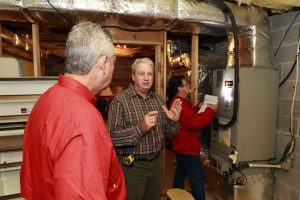Front Porch Blog
{ Editor’s Note } Guy Caroselli is the Local Energy Alliance Program’s senior technical advisor, but is also known as “The House Doctor.” He says he love mysteries and being challenged and shares has thirty-five years of experience in Home Performance and residential energy efficiency.

“The House Doctor,” Guy Caroselli, conducts an energy assessment at a Charlottesville, Va., home. Photo by Andrew Shurtleff
As the Local Energy Alliance Program’s senior technical advisor and trainer (a.k.a. “The House Doctor”), people ask me all of the time how they can make their homes work better – and shrink their energy bills.
As we approach winter, those questions are more frequent and urgent. Everyone has memories of being shocked by a January heating bill or fighting with a loved one over the thermostat setting. Based in Charlottesville, LEAP works with residents of central and northern Virginia to help them prevent those scenes from repeating for yet another winter season. How can you make sure your home is energy-efficient? Let’s start with a short quiz.
1. What is the biggest contributor to greenhouse gas in the Charlottesville area?
a) Commercial Enterprises
b) Homes
c) Transportation Sector
d) Municipal
2. The ENERGY STAR label designates:
a) Companies that save the most energy
b) High quality luxury products
c) The most energy-efficient products that can cut energy bills by up to 30%
3. On average, which home appliance uses the most annual energy?
a) Television
b) Refrigerator
c) Washing Machine
d) Computer
4. Reset your hot water temperature from 125 to 120 degrees you save each year?
a) $22
b) $6
c) $9
5. A home energy audit or assessment can help you:
a) Find hidden energy leaks
b) Determine which home upgrades will give you the best energy efficiency returns
c) Create a plan of action
d) All of the above
The answers? Drum roll please….
1. B
2. C
3. B
4. A
5. D
How did you do? Even if you aced the quiz, your home probably has plenty of room for improvement. In fact, most houses use (ahem, waste) 30-50 percent more than they need. That’s usually energy that we lose through inadequate insulation, cracks that need to be sealed, inefficient light bulbs and appliances.
You can estimate your costs by totaling up all of your utility bills and then dividing that total by the square footage of your house. The average homeowner spends about $1.25/sf when it should be around 75 cents/sf. Bringing those costs down might require an investment, but you can often earn that money back on lower energy bills in a relatively short period of time. A small air sealing job ($200-$400) can deliver a payback in 4-6 months whereas a more extensive job ($1,000-$1,500) may take 1-2 years. It’s a similar story with insulation: small job ($1,000-$2,000) has a 4-year payback, and more extensive work ($4,000-$8,000) can take 5-8 years to see a return.
Of course the specific culprits and solutions vary from house to house, and that’s the benefit of getting a Home Energy Check-up. You’ll get an evaluation of your home’s energy efficiency, the advice of an energy expert, free installation of energy efficient lightbulbs, pipe insulation, door weatherization and more — plus a checklist of additional energy saving measures for your home. Normally a service and products like this would cost up to $250. But because LEAP is a Participating Contractor in the Dominion Home Energy Check-up program our price to homeowners is only $45 ($35 if your neighbors participate, too). Plus this is an easy entry point to the Home Performance with ENERGY STAR program that can help you save 20 percent or more on your energy costs.
While you’re waiting for your Home Energy Check-up, there are easy, DIY steps you can take right now to get your home ready for winter. Here are just a few:
- Check the thermostat. Consider getting a programmable thermostat, and keep in mind that you can save at least 2 percent on your heating bill for each degree you lower the thermostat in the winter.
- If you have an AC system independent of a furnace or boiler, make sure you close the vents and block off any return ducts so warm, conditioned air does not rise up into the system
- For fireplaces you don’t intend to use this season, make sure the flue is closed and the openings cleaned of soot and filled with a string of rope caulk (and make a note that you have done this so you remember before the next use).
- Take an inventory of attic and crawlspace hatches to ensure they are all weatherstripped, secured with good clasps and insulated. The same applies to adjacent wall or ceiling areas if possible.
Learn more about LEAP by visiting leap-va.org, and read about the organization in The Appalachian Voice
PREVIOUS
NEXT
Related News

Leave a comment
Your email address will not be published. Required fields are marked *
